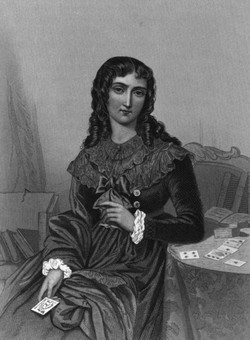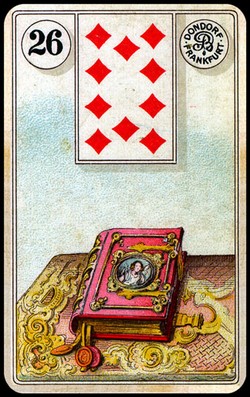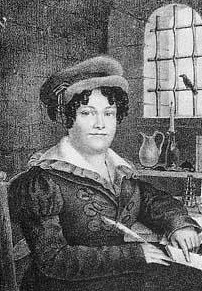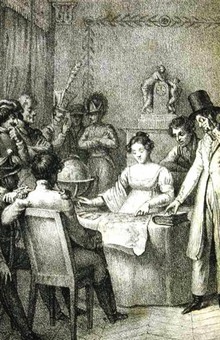|
Tarot History Search started September 2004 |
Marie Anne Adelaide Lenormand |
||
|
The socalled Lenormand Cards were produced after the death of Mademoiselle Lenormand
and they were given her name just using her legendary fame. Here you can find many examples of this deck type. Basic data for Anne Marie Lenormand: (* 27. Mai 1772 in Alençon, Basse-Normandie; ? 25. Juni 1843 in Paris). She claimed to have made cartomancy and very good predictions in many cases, and especially for many famous persons, for instance empress Josephine, Marat, Robespierre, St-Just and Zar Alexander in 1818. Variously she was accused and in prison. She wrote a lot of books and became a rich woman by her activities: 500.000 Francs are mentioned, the critical "Wicked pack of cards" reduces this to 120.000 Francs. The same critical "Wicked pack of cards" notes: "Not only was she the most popular clairvoyante of the first decades of the XIXth century, but she remains the most celebrated fortune-teller of all time." Lenormand cards are the name of some divination decks, which appeared after the death of Anne-Marie Lenormand - others authors used the well-known name for their own interests: The "Grand jeu de Mlle Lenormand" appeared 2 years after her death in the year 1845 and was offered together with a collection of 5 books. The author used the pseudonym "Mme la comtesse de ***" und the publisher had no name but only an address: "46 rue Vivienne". The deck had 54 Karten including a female and a male card presenting the consultant. The content of the 5 books included themes of astrology, chiromanty and other forms of divination. The pictures of the deck showed scenes of Greek mythology, star pictures, geomantic symbols, 22 letters (Kabbala), 7 talismans, playing cards and flowers. Variations of the cards (now with 55 cards) were produced ca. 1850 in Germany by the publisher J.F. Aug. Reiff with the name "Wahrsage-Karten der berühmten Mlle Le Normand". The "Petit Lenormand" with 36 cards was published also ca. 1850. This typus of cards was never produced in France, but was used by card producers in Germany, Austria, Belgium und in the Switzerland. Detlev Hoffmann had shown in 1972, that the game was based on the "Das Spiel der Hofnung, mit einer neuen Figurenkarten von 36 illum. Blättern. 2. verbesserte Auflage" (as 2nd edition published ca. 1800 by G.P.J. Bieling in Nurremberg). The game was only secondary meant as a fortune telling deck, its first use was a running game with dice. The cards were used as the running field and were poisitioned according to the numbers 1-36 (single cells had unlucky or lucky influence on the course of the run - as in other running games). Symbols and ciphers were the same as in the later "Petit Lenormand", each symbol was accompanied by a playing card miniature (either Ansbach or Bavarian/Paris pattern). A connected divination system with cards only used 32 of the 36 symbols. (Compare our collection of divination decks) Lenormand publications
Some of these you can find in the list below (most French, one text is translated in English), mixed with some more critical voices against Mademoiselle Lenormand. At the end are two English biographies. Oeuvres de F.-B. Hoffmann ... By François Benoît Hoffmann (1829); Les souvenirs prophetiques d'une sybille sur les causes secrètes de son arrestation, le 11 dècembre 1809; par mademoiselle M.-A. Lenormand (critique ; p. 339) Les oracles sibyllins; ou, La suite des Souvenirs prophétiques. By Marie-Anne Adélaïde Lenormand (1817) La sibylle au Congrès d'Aix-la-Chapelle, suivi d'un coup-d'oeil sur celui de ... By Marie-Anne Adélaïde Lenormand (1819) Oeuvres de F.-B. Hoffmann ... By François Benoît Hoffmann (1829) La sybille au congres d'Aix-la-Chapelle; (critique ; p. 362) Mémoires historiques et secrets de l'impératrice Joséphine, Marie-Rose ... By Marie-Anne Adélaïde Lenormand (1820) Historical and Secret Memoirs of the Empress Josephine (Marie Rose Tascher ... By Marie-Anne Adélaïde Lenormand, translated by Jacob Merritt Howard (1848) Mémoires de mademoiselles Avrillion, première femme de chambre de l'impératrice, sur la vie privée de Joséphine, sa famille et sa cour (1833) L'ange protecteur de la France au tombeau de Louis XVIII By Marie-Anne Adélaïde Lenormand (1824) Arrêt suprême des dieux de l'Olympe en faveur de Mme la duchesse de Berry et ... By Marie-Anne Adélaïde Lenormand (1833) The Court of Napoleon or Society Under the First Empire ... By Frank Boott Goodrich (3rd edition; 1859) - P. 318-333 Biography of Lenormand) Remarkable Women of Different Nations and Ages / Madame Lenormand (Published 1858 ; J.P. Jewett), p. 207-217 |
 "The prophetess was in person
"The prophetess was in person excessively fat and ugly." (from one of her biographies)  Cards called Lenormand-cards
Cards called Lenormand-cards didn't exist during her lifetime More examples of this deck type.  Lenormand in prison
Lenormand in prisonBelgium 1821  Lenormand with Napoleon
Lenormand with Napoleonphantasy scene |
|
| © copyright:
autorbis.net. Links at the site might lead to foreign
sources. We're not responsible for the contents of
these sites.
If you're interested to communicate or to add
informations to some of our articles or to publish articles to the theme of Tarot in 15th century, please send your mail to the webmaster |